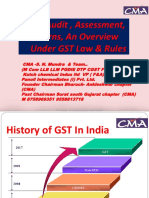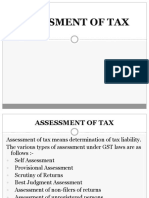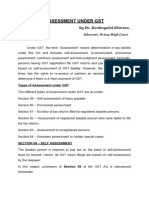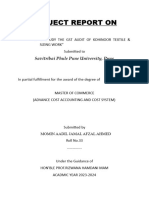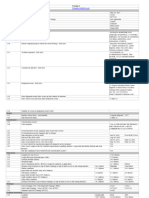0% found this document useful (0 votes)
26 views18 pagesGST Unit IV Complete Notes
The document outlines various types of assessments under GST, including self-assessment, provisional assessment, scrutiny assessment, and best judgment assessment, detailing the procedures and requirements for each. It emphasizes the importance of maintaining proper records and accounts, the mandatory fields for GST invoices, and the audit process for registered taxpayers. Additionally, it discusses penalties for non-compliance and the consequences of failing to maintain proper records, as well as the obligations of taxpayers during audits.
Uploaded by
ulnabeer755Copyright
© © All Rights Reserved
We take content rights seriously. If you suspect this is your content, claim it here.
Available Formats
Download as PDF, TXT or read online on Scribd
0% found this document useful (0 votes)
26 views18 pagesGST Unit IV Complete Notes
The document outlines various types of assessments under GST, including self-assessment, provisional assessment, scrutiny assessment, and best judgment assessment, detailing the procedures and requirements for each. It emphasizes the importance of maintaining proper records and accounts, the mandatory fields for GST invoices, and the audit process for registered taxpayers. Additionally, it discusses penalties for non-compliance and the consequences of failing to maintain proper records, as well as the obligations of taxpayers during audits.
Uploaded by
ulnabeer755Copyright
© © All Rights Reserved
We take content rights seriously. If you suspect this is your content, claim it here.
Available Formats
Download as PDF, TXT or read online on Scribd
/ 18








